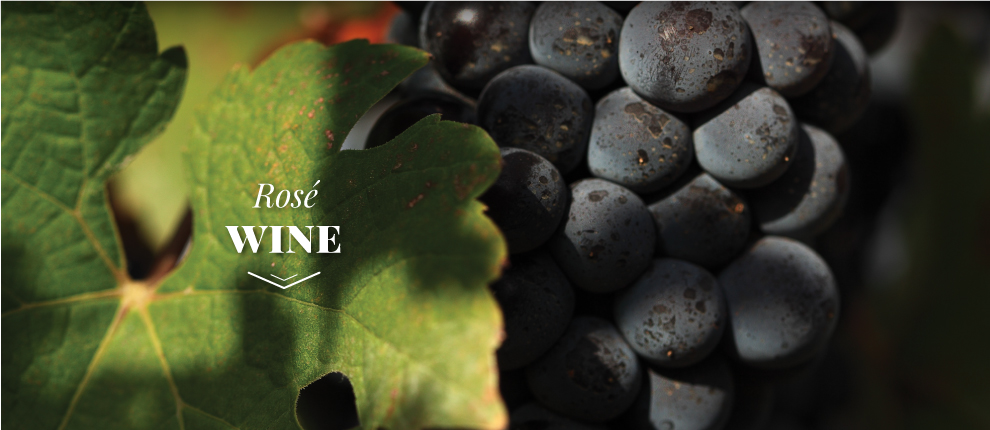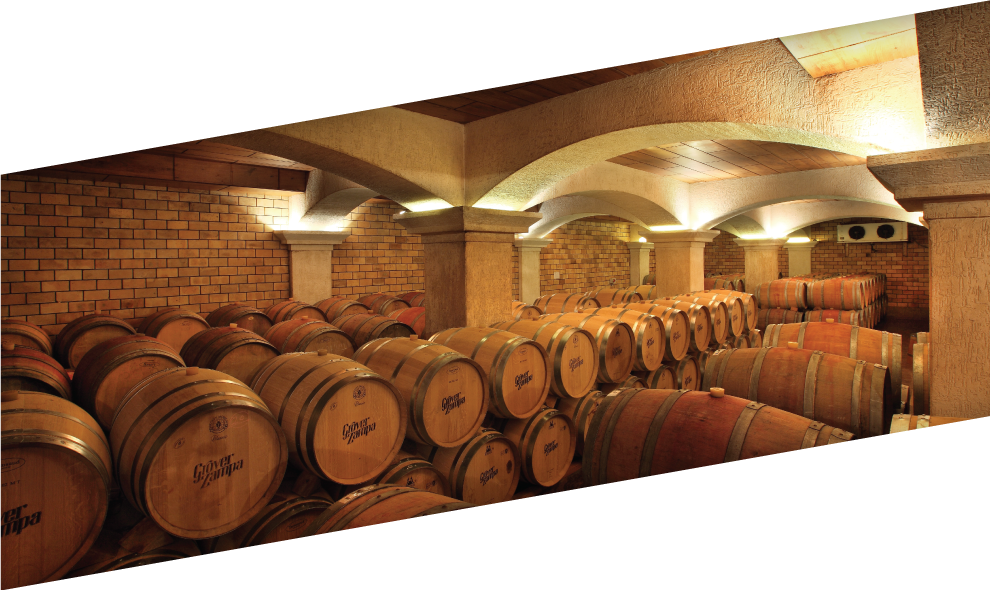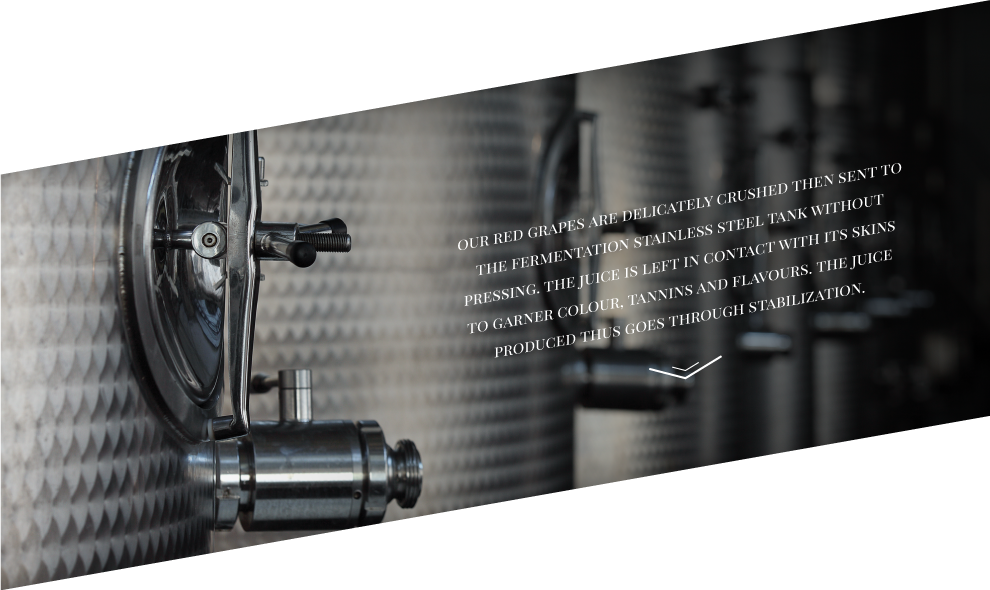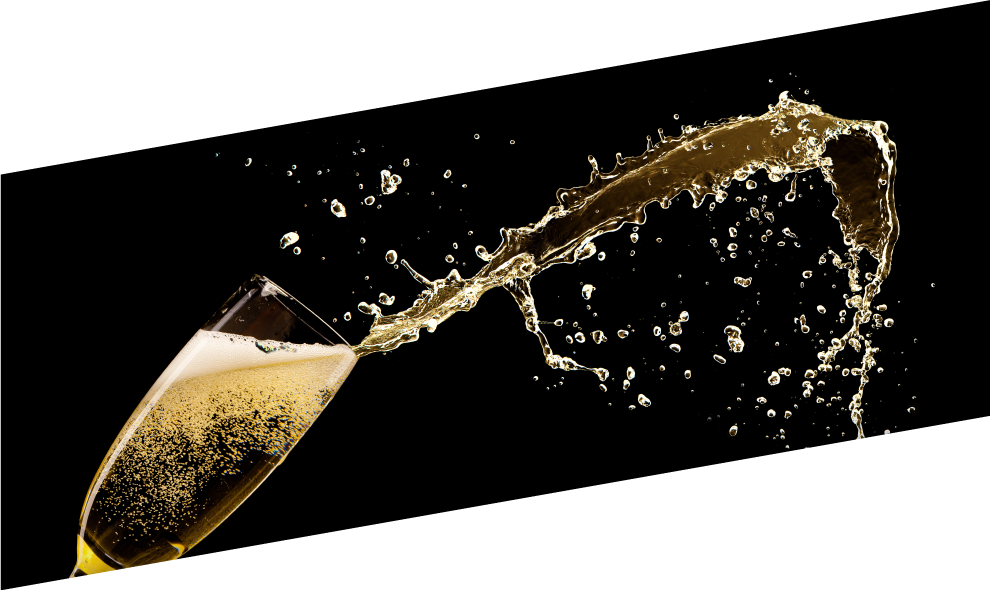
Chêne is a delightful combination of Spain’s most famous grape Tempranillo (55%) and the reliable Shiraz grape (45%). Before the last blending, all the steps are performed separately for both grape varieties.
Red grapes for Chêne are delicately crushed and transferred to the tank without pressing. The juice is left in contact with its skins and seeds to garner colour, tannins and flavours.
Then the juice is sent ahead for stabilization.
Once stabilization and fermentation is completed, the maceration process begins. For Chêne, this process is longer than for regular red wines. Chêne wine is in contact with the pomace for up to 40 days in order to extract more tannin. This gives the wine a deep and intense ruby colour. Tannins add the flavor and structure to the wine.
Furthermore, for optimum extraction of colour as well as tannin, regular pumping is done during fermentation and maceration.
After the maceration skins and wine are separated.
‘Free run juice’ is the first version of the wine which is taken straight out of the tank. It is very light in terms of colour and tannins. Rest of the remains from the tank (skins, seeds, deposit) is sent to the pneumatic press. The wine obtained now, has a much deeper red colour and has more tannin. This darker wine is called the ‘press juice’.
The two juices are blended together to obtain a more homogenous wine.
Next, the natural deposits and the lees need to be removed. This is done by the clarification process called racking.
Chêne goes through more than 10 racking cycles until the wine is completely clear. Here onwards, each grape variety goes through separate steps according to its needs since all types don’t react the same way to the processes.
At this stage, in order to have more homogeneity, the Tempranillo and Shiraz wines are blended.
Our Grand Réserve wine ages for a long period of 15 to 20 months in new oak barrels. This enables it to obtain luscious nuances of vanilla and cinnamon.
Before bottling, a last racking and a filtration are done to ensure the optimum quality of Chêne in your glass.

La Réserve is made from 80% of Cabernet Sauvignon (the grape of the famous Bordeaux wines) and 20% of Shiraz grape, both coming from our oldest vines.
The grapes are delicately crushed then sent to the fermentation stainless steel tank without pressing. The juice is left in contact with its skins to garner colour, tannins and flavours. The juice produced thus goes through stabilisation.
Temperature stabilisation is done by cooling the juice at 22°C for 24 hours, which, as we saw in the process of making of red winemaking, is suitable for fermentation. The addition of Yeast initiates alcoholic fermentation (22°C to 27°C).
The process of maceration begins once fermentation is completed. Similar to red wines’ procedure, tannin extraction is done with the help of pomace. This gives the La Réserve its very deep garnet purple. Colour is also extracted through regular pumping.
“Free run juice” is obtained after skins are removed. “Press juice” is the produced after further removal of skins and deposits in the pneumatic press. The two juices are blended together to obtain a more homogenous wine.
Clarification process is done in this case also to remove natural deposits. The racking cycles for La Réserve are increased to 10.
Here onwards, all steps are done separately for each grape variety according to individual needs.
At this stage, we blend the Cabernet Sauvignon and Shiraz wines to have more homogeneity. The blended premium wine ages for a minimum of 6 months in new oak barrels which enables it to obtain delicious chocolate, coffee beans and vanilla aromas.
Before bottling, a last racking and filtration are done to ensure the optimum quality.
La Réserve is now ready to be bottled.

Our Rosé wines are produced from red Shiraz grapes.
As for all our wines, we use a sorting table to only keep the best of fruits; the stems are removed to avoid any greenish and herbaceous aromas. What makes rosé wine different from red wine is the limited contact the juice has with the skins and seeds – as little as a few hours. When the juice reaches a bright light cherry or salmon colour it is removed from skin contact by using a pneumatic press.
Rosé winemaking is done by using exactly the same techniques as for a white wine.
The juice is moved to stainless steel tanks for stabilisation. The next step is fermentation; yeasts are transforming the sugar naturally present into alcohol.
No Malolactic Fermentation is done to our Rosé wines; this is to retain maximum freshness.
After the clarification process through 5 to 6 racking cycles, the wine is filtered and is finally ready to be bottled.

The wine-making process of red wine is fairly different than the making of white wine.
After a meticulous hand-picking of our grapes, it goes to the sorting table where unwanted elements like unripe grapes or leaves are removed. After this hand selection, we use a de-stemmer to avoid the greenish aromas and water that the stems give off.
Red grapes are delicately crushed and sent to the fermentation stainless steel tank without pressing. The juice is left in contact with its skins to garner colour, tannins and flavours. The juice produced thus goes through stabilisation.
Temperature stabilisation is done by cooling the juice at 22°C for 24 hours, conditions that are more suitable for the red wine fermentation. Stainless steel tanks are used for this. Yeast is added to induce alcoholic fermentation which starts at 22°C and stops around 27°C. A lot of CO2 is also produced and the tanks are left open until fermentation is completed.
Once the fermentation is complete, the maceration process begins. We leave the wine in contact with the pomace or marc: skins, pulp and seeds for 20 days in order to extract more colour and tannins. The tannins bring flavour and structure in red wines. During both fermentation and maceration, regular pumping is also done to ensure the optimum extraction of colour as well as tannins.
After the maceration process, skins and wine are separated. The first wine we obtain coming from the tank is called “free run juice” which is very light in terms of colour and tannins. All that remains in the tanks like skins, seeds, deposit, go to the pneumatic press. The wine thus obtained has a much deeper and darker red colour and has more tannin. This is called the “press juice”. Our winemakers blend those two wines together to obtain a more homogeneous wine.
Clarification, as in the case of white wines, is done to remove the natural deposit or lees. The process of ‘racking’ requires a transfer of fermented juice from one tank to another. Reds at Grover normally goes through 8 to 10 racking cycles until the wine is totally cleared.
The next step is the Malolactic fermentation. This fermentation is about transforming the Malic Acid, which gives the sensation of greenness in the wine, into Lactic Acid, which reduces the astringency of the wine and increases the colour of red wines. Malolactic fermentation reduces acidity and ‘softens’ the tannins of the wine.
The winemakers take care of the blending to give to our reds their distinctive style and taste.
Depending on the range, the wine ages for a period of 6 to 20 months in stainless steel tanks or oak barrels.
To ensure the finest taste, one more filtration is done.
Our red wine is now ready to be bottled.

Out of the three methods of producing sparkling wines, the “Methode Traditionnelle” is the most costly and labour-intensive, but gives the best quality sparkling wines. This is why our winemakers use this method.
The first step to produce a sparkling wine is to produce a still white or rosé wine. This depends on whether it’s intended for the Zampa Soirée Brut made from Chenin Blanc, or the Zampa Soirée Brut Rosé made from Shiraz. This is called base wine. We harvest it a bit earlier to have a higher acidity which gives that crispness to the wine. We use a de-stemmer as well as the sorting table to keep only the best of our fruits. For our Zampa Soirée Brut, the grapes go directly to the press, and for our Zampa Soirée Brut Rosé, the skin is kept in contact for an hour with the juice to give it a light pale red colour and red fruity aromas, before going to the press.
As for all our still whites and rosés, the juice is filled into stainless steel tanks for stabilization. Temperature stabilization is done by cooling the juice between 10°C and 15°C for 24 hours, conditions that are more suitable for the white and rosé wine fermentation. Yeasts are added to induce the alcoholic fermentation. The action of the yeasts is to transform the sugar naturally contained in the grape juice into alcohol. A lot of CO2 is also produced, hence it is very important to leave the tanks open until the fermentation is finished.
We have our base wine.
The next step is the Malolactic fermentation, which is the same as that in making of white wine. Malic Acid is converted into Lactic Acid in this process.
Now starts the Methode Traditionnelle, to make sparkling wine from the base wine obtained earlier.
After a clarification process, we bottle the wine in traditional sparkling bottles. We add yeasts and sugar into the bottle: this is called “liqueur de tirage”. We put the “bidule” (a small plastic cup that fits in the bottle’s neck and into which the sediment eventually settles) and cork the bottle with a cap for a while. When yeasts come in contact with sugar, fermentation starts. It is during this second fermentation into the bottle, that we obtain those fine and natural bubbles. Temperature is very important during this stage; the cooler the fermentation, the finer the bubbles in the finished product. That is why we store the bottles close to the oak barrels in our temperature controlled cellar.
After this second fermentation is complete, dead yeast cells break down and settle at the bottom or attach to the side of the bottle. At this point it is determined how long the wine will remain “en tirage”, or on the yeast. Extended yeast contact gives wine a “yeasty” characteristic plus added complexity of secondary flavors. Once the desired time has passed, the sediment must be removed without losing the sparkle. The first step in this process is riddling or remuage.
For this task we use a riddling machine, a large bin attached to gyro-pallets with a timer which methodically turns the bottle from a horizontal position to an upside-down vertical position. The goal is to collect the sediments in the neck of the bottle to remove it more easily. It is done by quickly freezing the bottle’s neck in a freezing bath. By removing the cap, the pressure will push out the bidule with sediments which are in the frozen plug. This is called disgorgement.
After disgorgement, there is a lack in the bottle, which is filled by adding a tiny amount of wine and sugar depending on the sweetness we want to have in our final sparkling wine.
The wine is finally ready to be corked; we also add a wire hood.

While red wines are fermented with the skins and seeds of grapes, white wines are fermented using only clear grape juice.
From our vineyards to our cellar, great importance is given to meticulous grape selection to ensure the use of the best-quality grapes. After going through the sorting table where our team carefully removes the unwanted berries or leaves, our grapes are fully de-stemmed to avoid greenish aromas and to get only the best fruits. The best wine is thus provided to you.
The next step is pressing, where the juice is separated from the skins. In the case of white wine, grapes are pressed quickly in order to separate the juice from the skin, seeds and other solids. The juice produced then goes through stabilisation.
The juice is filled into stainless steel tanks for stabilisation. Temperature stabilisation is done by cooling the juice between 10°C and 15°C for 24 hours (conditions suitable for the white wine fermentation). Yeasts are added to induce alcoholic fermentation. The action of yeasts is to transform the sugar naturally contained in the grape juice into alcohol. A lot of CO2 is also produced, which is why it is very important to leave the tanks open until the fermentation is finished.
Once the fermentation is completed, depending on the style of wine we want, the ageing is done in either stainless steel or oak barrel. Next, the clarification process begins. Clarification is done by transferring the fermented juice from one tank to another in order to remove the natural deposit or lees. This process is called racking. Our whites normally go through 5 to 6 racking cycles until the wine is totally cleared.
The next step is not necessarily done to all white wines but to all red. This is called Malolactic Fermentation. This fermentation is not about alcohol; it is about transforming the Malic Acid into Lactic Acid. It reduces and ‘softens’ the acidity of the wine. Depending on the level of acidity of our white wines, we may apply this step to give them more softness.
Before bottling, one filtration is done to ensure the optimum quality of our wines in your glass. Our white wines are now ready to be bottled.





